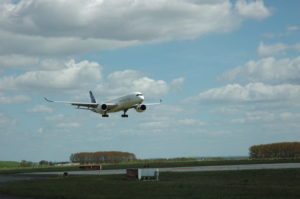
These EGNOS (European Geostationary Navigation Overlay Service)-based approaches are considered ILS look-alikes, as the LPV-200 service level is compliant with International Civil Aviation Organisation (ICAO) Annex 10 Category I precision approach performance requirements, but without the need for the expensive ground infrastructure required for ILS.
“EGNOS LPV-200 is now the most cost-effective and safest solution for airports requiring CAT I approach procedures,” says GSA Executive Director Carlo des Dorides. “The involvement of major aircraft manufacturers confirms that this service is a real added-value for civil aviation, setting the basis for a better rationalisation of nav-aids in European airports.”
The announcement of the approach implementation follows the publication of the EGNOS-based procedures on 28 April.
The publication of LPV-200 procedures provides numerous benefits, including:
- reduced delays, diversions and cancellations thanks to the lower minima, potentially reducing the operational costs for flying to LFPG;
- increased continuity of airport operations in case of ILS outage or maintenance;
- enhanced safety levels, as the LPV-200 procedures can serve effectively as CAT I approach procedures and can also be used as a back-up to ILS-based procedures;
- improved efficiency of operations, lowering fuel consumption and CO2 emissions, and decreasing aviation’s environmental impact.
An important milestone
“The LPV-200 service provides European airports with the means to implement the most demanding precision-based navigation operations as defined by the ICAO,” explains EGNOS Service Provider (ESSP) CEO Thierry Racaud.
DSNA, the French Air Navigation Service Provider, pioneered the procedures as an outcome of the work that was co-financed by the European Union and carried out since the GSA declared the EGNOS LPV-200 service operational on 29 September 2015.
“The new LPV-200 approach procedures now implemented at LFPG aim to demonstrate that the satellite-based augmentation systems (SBAS), such as EGNOS in Europe, is a Category I performance approach solution that is reliable,” says Maurice Georges, DSNA CEO. “We are convinced that SBAS is a fundamental technology to modernise our navigation infrastructure and, following this first implementation, LPV-200 approach procedures will be progressively deployed over our IFR runway-ends network.”
Pilot approved
The approach has been flown by an ATR 42-600, Dassault Falcon 2000 and Airbus A350, with positive pilot feedback. “The LPV -200 system is much more stable and more reliable in terms of safety, but also more efficient than the ILS approach,” says ATR Chief Pilot Eric Delesalle after completing the first LPV-200 landing on runway 26L at LFPG. “It really makes a difference.”
According to Delesalle, LPV approaches offer pilots several distinct advantages over an ILS approach. For instance, the LPV system allows one to land at more runways, even in low visibility conditions, and LPV gives a pilot the accuracy of an ILS without the problems of localiser or glide slope interference. “With LPV, pilots can use GPS navigation during all phases of an approach, meaning they do not have to switch between autopilot modes while preparing the approach, thus our overall workload is reduced and room for human error is reduced” he adds.
“Airbus is pleased to have demonstrated that the A350 XWB complies with the new RNAV (GNSS) approaches with satellite-based augmentation, as implemented at Paris Charles de Gaulle,” adds Airbus Experimental Test Pilot Jean-Christophe Lair. “These approaches will be a valuable back-up to the airport’s traditional ILS approaches and will maximise runway availability for the A350 by maintaining CAT 1 capability, down to a 200 feet decision height, even when the ILS ground station is not available.”
According to Dassault Flight Test Pilot Jean-Louis Dumas, from a pilot point of view, there is no difference between ILS and LPV approaches as the design of the Falcon EASY cockpit and the overall workload is exactly the same for both. “The accuracy and stability of the LPV guidance is really amazing,” says Dumas. “Lowering the LPV minima down to 200 feet in Europe is a great improvement enabled by EGNOS, and is very valuable for business aviation operations.”
In order to take advantage of LPV approaches, a pilot must undergo a specific initial training to learn all GPS-related navigation specifications, including LPV 200 procedures. However, as all three test pilots confirmed, as LPV approaches were intentionally developed as ILS look-alike, pilots are able to quickly transfer and adjust their skills to the new generation of LPV approaches.
Paving the way for future implementation
The GSA expects that by launching the first LPV-200 procedure at such an international hub as Charles de Gaulle will pave the way for the publication of additional LPV-200 service-level procedures at other European airports. In fact, it is already confirmed that Vienna International (LOWW) is set to be the next airport to publish LPV-200 procedures.

